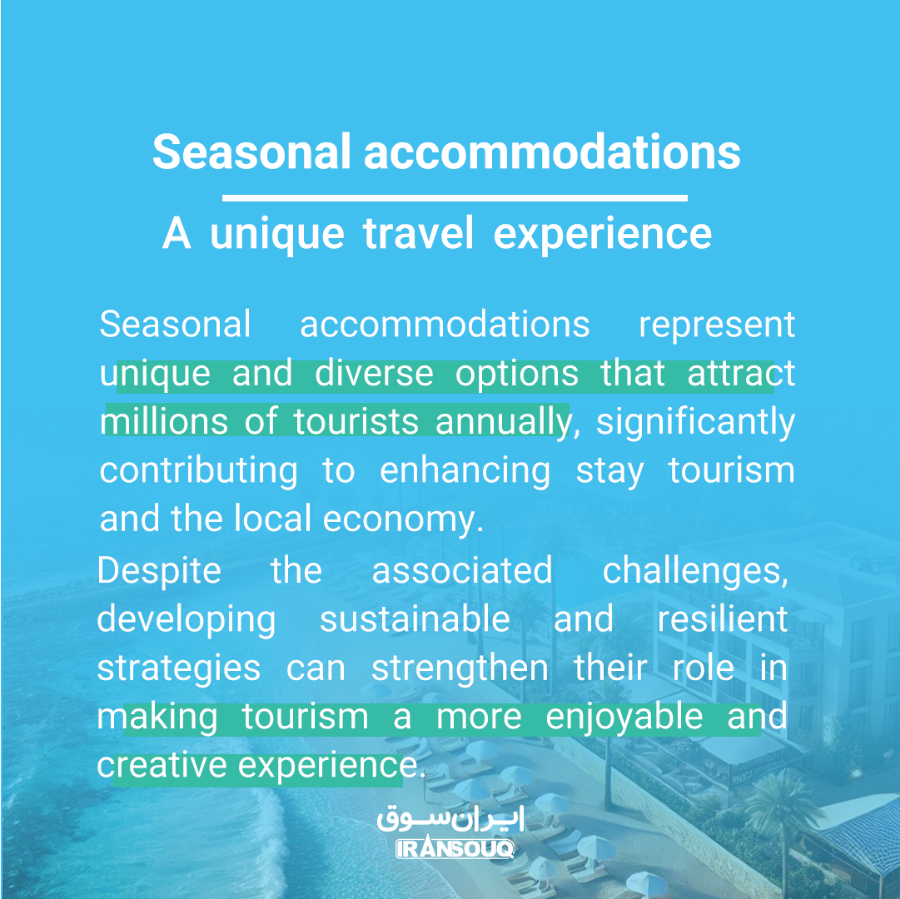
Seasonal Accommodations and Stay Tourism: Interrelations and the Importance of Development
Introduction
Seasonal accommodations are a prominent aspect of stay tourism, characterized by their temporary nature and association with specific seasons. They cater to the needs of visitors to areas known for their natural, cultural, or climatic attractions at different times of the year. Whether in coastal regions during summer or mountain resorts in winter, seasonal accommodations play a vital role in promoting stay tourism and boosting the local economy. This article aims to highlight the concept of seasonal accommodations, their various forms, their relationship with stay tourism, and their significance in the tourism industry.
---
The Concept of Seasonal Accommodations
Seasonal accommodations refer to residential units or tourism facilities that offer accommodation services for a specific period of the year, coinciding with a particular tourist season. These range from mountain cabins and seaside villas to furnished seasonal apartments. They are often designed to meet the expectations of tourists traveling for leisure, recreation, or seasonal activities, such as skiing or sunbathing.
Characteristics of Seasonal Accommodations:
1. Temporary Nature: Their availability depends on a specific season or period (e.g., summer or winter).
2. Location: Often situated in natural tourist areas like beaches, mountains, or deserts.
3. Limited Infrastructure: May be less equipped compared to permanent establishments like hotels.
4. High Demand During Tourist Season: Occupancy rates rise sharply during peak season, significantly decreasing outside this period.
---
The Relationship Between Seasonal Accommodations and Stay Tourism
Seasonal accommodations form a crucial dimension of stay tourism for several reasons:
1. Adapting to Tourist Seasons: The presence of seasonal accommodations allows for the utilization of natural resources or climates to offer a unique experience to visitors.
2. Supporting Diversification of Tourist Activities: These accommodations provide various options suitable for seasonal activities like skiing in winter or water sports in summer.
3. Boosting the Local Economy: Local communities heavily rely on the money spent by tourists during the season.
4. Developing New Tourist Destinations: Seasonal accommodations often cover areas not utilized for tourism year-round.
---
Types of Seasonal Accommodations
1. Winter Resorts: Include mountain cabins and lodges in snowy areas, often used as accommodation for tourists participating in activities like skiing or snowmobiling.
2. Coastal Accommodations: Encompass villas and chalets overlooking beaches, attracting visitors during warm and summer seasons.
3. Desert Accommodations: Offer tourists a unique desert experience, such as safari tours or desert camping, particularly during winter when temperatures are lower.
4. Seasonal Rural Villages: Remote villages and farms have become popular destinations, especially during summer or weekend getaways, providing a natural tourism experience away from urban noise and pollution.
---
#### The Role of Seasonal Accommodations in Enhancing Stay Tourism
Seasonal accommodations are a key driver in the development of stay tourism by contributing to several areas:
1. Developing Local Tourism Activity: In remote areas or those with unique tourist resources.
2. Diversifying Economic Power: By employing numerous local residents and providing seasonal job opportunities.
3. Promoting Sustainable Tourism: Through the use of natural resources with minimal environmental impact, especially with a focus on creating eco-friendly accommodations.
---
Challenges Facing Seasonal Accommodations
Despite their numerous benefits, seasonal accommodations face several challenges, including:
1. Limited Usage Periods: Demand decreases during off-seasons, leading to potential losses.
2.Demand Fluctuation: The dependence of seasonal accommodations on specific seasons makes them vulnerable to climatic or economic changes.
3. Environmental Damage: The concentration of tourists in certain areas can lead to environmental damage such as pollution.
---
#### Recommendations for Developing Seasonal Accommodations
To mitigate challenges and enhance benefits, the following steps can be taken to develop seasonal accommodations:
1. Promoting Sustainability: By using eco-friendly building materials and providing renewable energy.
2. Extending the Tourist Season: By providing recreational activities or events outside peak times.
3. Investing in Technology: To facilitate online booking and improve the accommodation experience for tourists.
4. Innovative Marketing: To promote the location and accommodation services nationally and internationally.
---
#### Conclusion
Seasonal accommodations represent unique and diverse options that attract millions of tourists annually, significantly contributing to enhancing stay tourism and the local economy. Despite the associated challenges, developing sustainable and resilient strategies can strengthen their role in making tourism a more enjoyable and creative experience. Attention to seasonal accommodations also means highlighting the natural and cultural heritage of host regions, making them an important factor in the sustainable growth of the tourism industry as a whole.




